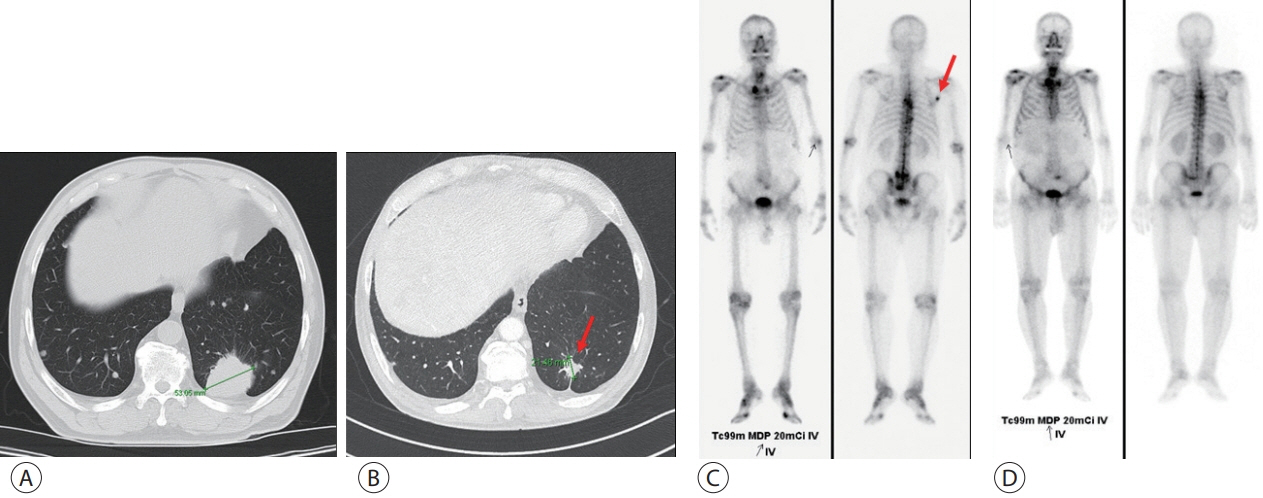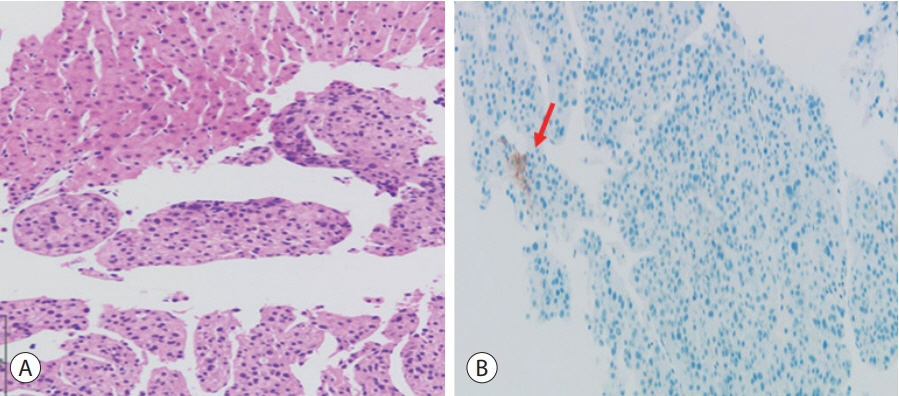J Liver Cancer.
2023 Mar;23(1):230-234. 10.17998/jlc.2023.03.03.
The development of hepatocellular carcinoma during long-term treatment for recurrent non-small cell lung cancer: a case report
- Affiliations
-
- 1Department of Internal Medicine, Inje University Sanggye Paik Hospital, Seoul, Korea
- 2Department of Internal Medicine, Korea University College of Medicine, Seoul, Korea
- KMID: 2540837
- DOI: http://doi.org/10.17998/jlc.2023.03.03
Abstract
- Multiple primary malignancies (MPMs) are defined as the presence of two or more malignancies in different organs, without a subordinate relationship. Although rarely reported, hepatocellular carcinoma (HCC) occasionally presents with simultaneous or metachronous primary malignancies in other organs. In this report, we describe a patient with lung adenocarcinoma and lymph node and bone metastases, treated with five chemotherapeutic regimens for 24 months. Changing the chemotherapy regimen based on the suspicion of metastasis of a new liver mass did not lead to improvements. This prompted a liver biopsy and a revised diagnosis of HCC. Sixth-line treatment with the concurrent use of cisplatin-paclitaxel for lung cancer and sorafenib for HCC, stabilized the disease. The concurrent treatment was not tolerated and was discontinued owing to adverse events. Considering our findings, treatment with increased efficacy and lower toxicity for MPMs is warranted.
Figure
Reference
-
References
1. Luciani A, Balducci L. Multiple primary malignancies. Semin Oncol. 2004; 31:264–273.
Article2. Hayat MJ, Howlader N, Reichman ME, Edwards BK. Cancer statistics, trends, and multiple primary cancer analyses from the surveillance, epidemiology, and end results (SEER) program. Oncologist. 2007; 12:20–37.
Article3. Xu W, Liao W, Ge P, Ren J, Xu H, Yang H, et al. Multiple primary malignancies in patients with hepatocellular carcinoma: a largest series with 26-year follow-up. Medicine (Baltimore). 2016; 95:e3491.4. Das S, Johnson DB. Immune-related adverse events and anti-tumor efficacy of immune checkpoint inhibitors. J Immunother Cancer. 2019; 7:306.
Article5. Amer MH. Multiple neoplasms, single primaries, and patient survival. Cancer Manag Res. 2014; 6:119–134.
Article6. Dhandha M, Chu MB, Richart JM. Coexistent metastatic melanoma of the kidney with unknown primary and renal cell carcinoma. BMJ Case Rep. 2012; 2012:bcr2012007286.
Article7. Yamada H, Hida N, Satoh H, Yamagishi T, Hiroshima Y, Yoshii S, et al. Improved outcomes with pembrolizumab treatment in two cases of double cancer including non-small-cell lung cancer. Anticancer Drugs. 2019; 30:105–109.
Article8. Yamaguchi T, Sakurai K, Kuroda M, Imaizumi K, Hida T. Different response to nivolumab in a patient with synchronous double primary carcinomas of hypopharyngeal cancer and non-small-cell lung cancer. Case Rep Oncol. 2017; 10:802–808.
Article9. Nozawa Y, Oka Y, Oosugi J, Takemura S. Immunotherapy for pulmonary squamous cell carcinoma and colon carcinoma with pembrolizumab: a case report. Medicine (Baltimore). 2018; 97:e0718.10. Ribas A, Wolchok JD. Cancer immunotherapy using checkpoint blockade. Science. 2018; 359:1350–1355.
Article11. Finn RS, Qin S, Ikeda M, Galle PR, Ducreux M, Kim TY, et al. Atezolizumab plus bevacizumab in unresectable hepatocellular carcinoma. N Engl J Med. 2020; 382:1894–1905.
Article12. Rittmeyer A, Barlesi F, Waterkamp D, Park K, Ciardiello F, von Pawel J, et al. Atezolizumab versus docetaxel in patients with previously treated non-small-cell lung cancer (OAK): a phase 3, open-label, multicentre randomised controlled trial. Lancet. 2017; 389:255–265.
Article13. Aoki H, Matsumoto N, Takahashi H, Honda M, Kaneko T, Arima S, et al. Immune checkpoint inhibitor as a therapeutic choice for double cancer: a case series. Anticancer Res. 2021; 41:6225–6230.
Article14. Hayashi H, Nakagawa K. Combination therapy with PD-1 or PD-L1 inhibitors for cancer. Int J Clin Oncol. 2020; 25:818–830.
Article
- Full Text Links
- Actions
-
Cited
- CITED
-
- Close
- Share
- Similar articles
-
- A Case of Long Term Survival in Patient with Early Intrahepatic Recurrence and Extrahepatic Metastasis after Curative Resection of Hepatocellular Carcinoma
- Druggable Targets of Squamous Cell Lung Cancer
- Adjuvant Chemotherapy for Completely Resected Non-Small Cell Lung Cancer
- Multiple primary lung cancer: Synchronous small cell lung carcinoma and squamous cell carcinoma
- Alterations of the Apoptosis Genes and Their Products in Non-small Cell Lung Cancer Tissues





